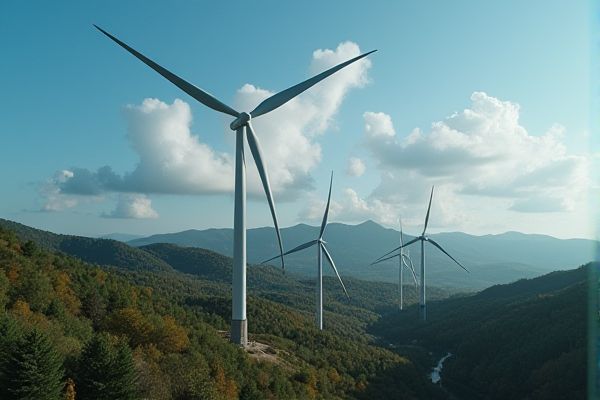
AI enhances wind energy systems by optimizing turbine performance and predicting maintenance needs. Machine learning algorithms analyze vast datasets from turbine sensors, enabling real-time monitoring and fault detection. This proactive approach minimizes downtime and reduces operational costs. Through advanced modeling, AI can also forecast wind patterns, improving energy output and grid integration.
AI usage in wind energy systems
Predictive Maintenance
AI enhances predictive maintenance in wind energy systems by analyzing data from turbines to forecast potential failures. This can lead to reduced downtime and lower operational costs, improving overall efficiency. By implementing AI algorithms, such as machine learning, operators can optimize maintenance schedules based on specific turbine performance data. For example, companies like Siemens Gamesa are leveraging AI to enhance their maintenance strategies, maximizing energy output and reducing risks.
Wind Speed Forecasting
AI can enhance wind energy systems through improved wind speed forecasting, which optimizes energy output. By analyzing historical weather data, AI algorithms can predict wind patterns with greater accuracy, reducing uncertainty in energy production. For example, institutions like the National Renewable Energy Laboratory utilize AI to refine their forecasting models. This could lead to more effective grid management and better integration of renewable energy sources.
Turbine Efficiency Optimization
AI can enhance wind energy systems by optimizing turbine efficiency through advanced data analysis. Machine learning algorithms can predict maintenance needs, reducing downtime and improving overall performance. For example, institutions like the National Renewable Energy Laboratory utilize AI to analyze turbine data, leading to better energy output predictions. This approach increases the potential for cost savings and maximizes energy production from wind resources.
Load Balancing
AI has the potential to optimize load balancing in wind energy systems, enhancing overall efficiency. By accurately predicting wind patterns and energy demand, AI can improve the integration of renewable sources into the grid. Companies like Siemens Gamesa are already exploring AI solutions to maximize energy output while reducing operational costs. This technology could lead to a more reliable energy supply and increased adoption of sustainable practices.
Energy Yield Prediction
AI techniques can improve energy yield prediction in wind energy systems by analyzing historical weather patterns and turbine performance data. Machine learning algorithms can identify trends and optimize energy output, leading to potentially higher efficiencies. For example, institutions like the National Renewable Energy Laboratory (NREL) have explored AI models to enhance forecasting accuracy. This application increases the chance of maximizing renewable energy utilization and operational cost savings.
Fault Detection and Diagnosis
AI can enhance fault detection and diagnosis in wind energy systems, potentially increasing operational efficiency. By analyzing data from sensors installed on turbines, AI algorithms can identify patterns indicative of malfunctions. For instance, a study by the National Renewable Energy Laboratory highlights how machine learning can predict failures before they occur. This proactive approach may reduce downtime and maintenance costs, offering significant advantages for energy producers.
Grid Integration
AI can optimize the performance of wind energy systems by predicting energy production based on weather patterns. Integration with the electrical grid can enhance efficiency and reliability by ensuring that generated power aligns with demand. For example, algorithms can analyze real-time data to inform grid operators about available energy from sources like offshore wind farms. This can lead to reduced operational costs and increased renewable energy adoption, ultimately benefiting the energy sector.
Data-Driven Performance Analysis
AI can enhance wind energy systems by optimizing turbine performance through data-driven analysis. Predictive maintenance models can reduce downtime and operational costs, benefiting institutions like Siemens Gamesa in their turbine management. Machine learning algorithms can analyze vast datasets to forecast energy production more accurately. This improves decision-making and may lead to increased energy efficiency and reduced waste.
Supply Chain Management
AI can optimize wind energy systems by predicting wind patterns and improving energy output efficiency. In Supply Chain Management, implementing AI can enhance inventory management and reduce costs. For instance, using AI tools can streamline logistics for companies like Siemens Gamesa, ensuring timely delivery of turbine components. The potential for increased operational efficiency in both sectors presents a significant advantage for businesses willing to adopt these technologies.
Environmental Impact Assessment
AI technology can enhance wind energy systems by optimizing energy production and reducing downtime through predictive maintenance. Implementing AI in Environmental Impact Assessments allows for more accurate modeling of ecological effects, leading to better-informed decisions. Companies like Siemens Gamesa are already exploring AI solutions to increase efficiency in turbine performance. The possibility of these advancements suggests significant long-term benefits for sustainable energy development and environmental protection.
 techknowy.com
techknowy.com